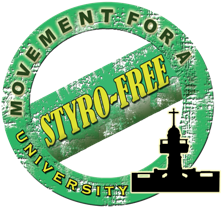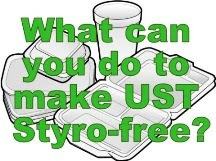------------------------------------------------------
STYROPOR IS EVERYWHERE…
- It is found in our home, office, grocery, eateries and in school. It comes in many shapes and forms from meat trays, soup bowls and salad boxes, coffee cups and plates.
- Styropor is already part of our daily life especially in urban centers.
WHY DO WE USE STYROPOR?
- Because they are cheap, accessible and disposable. Styropor suits our fast-paced lifestyle.
- Food in styropor is easy to serve. No need to wash and clean food containers. What we need is hot water, microwave and garbage container.
- In UST, food is served in styropor containers during meetings, seminars, or parties. Some eateries inside the University use styropor containers so consumers have no choice.
WHY REDUCE THE USE OF STYROPOR…
- Styropor food containers cannot be recycled. It means one time use of the material. It is also is petroleum- based so it is made of non renewable resource.
- Styropor is not environmentally-friendly.
- As much as possible the life span of a material should be prolonged by reusing or recycling. This is to reduce the further extraction of the earth’s capital.
- Officials of the National Institute of Health Sciences in Japan were cited as saying that "polystyrene containers, commonly used in the packaging of instant noodles and fresh foods in supermarkets, have been found to contain toxic substances known to disrupt the reproductive functions of animals and humans."
FROM THE WASTE STREAM…
- Styropor is not segregated but mixed with other wastes.
- Leonel collects the garbage in the MRF to be transported in the city disposal facility.
- Styropor is non-biodegradable so it will just pile up in the dumpsite. It takes so many years for styropor to degrade, which means that the chemical contents leach into the groundwater and soil.
- Garbage is combustible due to methane gas, so the solid styropor is now transformed into gaseuos phase which we inhale.
HOW DO WE WORK TOWARDS A STYRO-FREE UNIVERSITY?
- Harnessing the power of Information
- Nurturing sectoral dialogue
- University policy we can hold on
- Touching lives
- Advocate research-based initiatives
- Act and move on
HARNESSING THE POWER OF INFORMATION - We want to empower the Thomasians toward a styro-free University (SFU) thus information strategies are important.
- SFU has to start in the boardroom or classrooms. Explore the kindness of our faculty, the media in the University and other organizations.
- What persuasive strategies are we going to use to convince the Thomasians not to use styropor? What innovative ideas are we going to present to the Thomasians?
NURTURING SECTORAL DIALOGUE - There is a need to create harmonious relations in the university while we are campaigning for SFU. So let us sit and talk on how to reduce and eventually eliminate styropor in UST.
- Invite the business sector, admin, non-academic groups, student orgs, parish officials, University media and faculty clubs to a meeting regarding the campaign.
- How do we convince them business sector and the admin in the University that styropor can bring irreparable damage to human health and environment?
- What are the options that can be used for food packaging?
UNIVERSITY POLICY WE CAN HOLD ON - People in the admin may be replaced after their term of Office but the campaign should continue.
- We should have a clear policy on environmental protection that should be sustained regardless of who ever is holding the reign.
- What Office in UST is in-charge of the environment?
TOUCHING LIVES - The SFU should be participatory. OCD initiated it but all of us should participate. This forum should create domino effects in UST.
- The students should lead and not the janitorial services.
ADVOCATE RESEARCH-BASED INITIATIVES - The SFU campaign should be presented in numbers and narratives. We have to track records of success. There has to be a target date for each activity.
- Ex. How many % do we want to reduce in five months, ten months, in a year?
- How do we monitor and evaluate the campaign after one schoolyear?
- What are the weaknesses and strengths of the campaign?
ACT AND MOVE ON - The earth is finite and every living thing is important. Thus we have the moral responsibility to take care of the environment because it has limitations.
- We have to respect the right of others to enjoy the abundance of the environment by refusing to use styropor, reducing the use of other non biodegradable wastes, enhance reuse and recycle.
STYRO-FREE UNIVERSITY - Is an indicator that UST has a strong support system where everyone cooperates and work together for a common goal.
- It is a manifestation that the Thomasians are responsible and mature members of our society.
- It means UST cares for the environment. That UST is a caring University.
At the end of the day… God will ask you: What have you done to my creation?
Ano ang isasagot mo, kapwa ko Tomasino?
------------------------------------------------
Assoc. Prof. Arlen A. Ancheta is a research faculty. She is currently the Chair of AB Humanities Dept. She teaches Environmental Economics, Global Environmental Politics and Geography in AB at the same time conducting research on estero management in Manila. She finished her MS and Ph.D in Environmental Science in UPLB. Her areas of specialization are urban ecology, solid waste management and street children.





